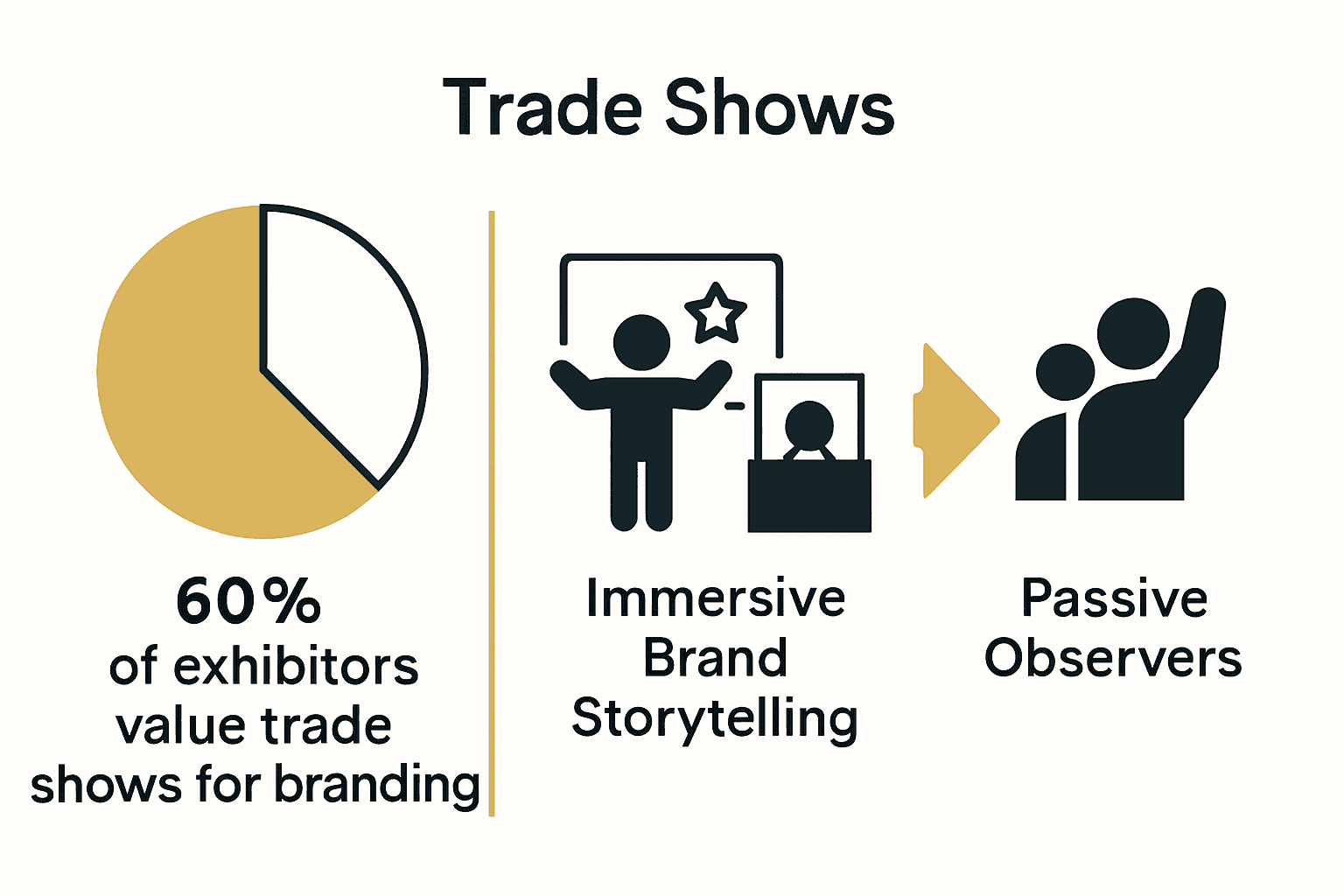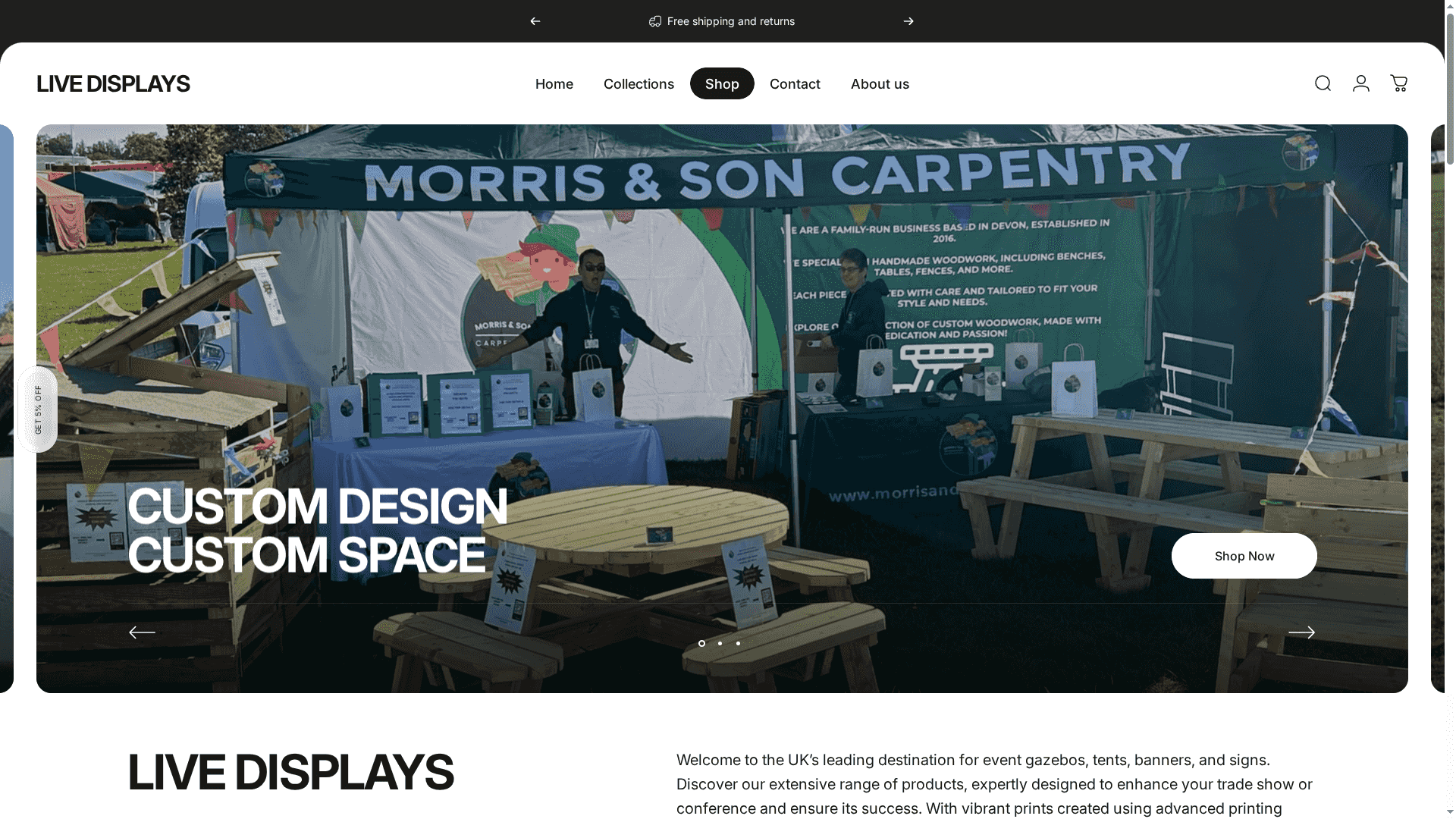More than 60 percent of exhibitors say trade shows play a vital role in shaping how their brands are perceived. The energy and competition on the show floor offer unique chances for companies to connect, influence, and stand out in ways that digital campaigns alone cannot achieve. Understanding the true impact of branding at these events helps businesses transform fleeting encounters into powerful, lasting impressions that drive real growth.
Table of Contents
- Branding Impact At Trade Shows Defined
- Types Of Trade Show Branding Strategies
- Key Elements Of Effective Trade Show Branding
- Role Of Display Solutions In Brand Visibility
- Common Branding Mistakes To Avoid At Trade Shows
Key Takeaways
| Point | Details |
|---|---|
| Importance of Brand Experiences | Trade shows are opportunities for immersive brand storytelling, crucial for enhancing brand equity and forming connections with potential clients. |
| Strategic Branding Approaches | Tailored branding strategies, including visual storytelling and customer engagement, are essential for maximizing trade show impact. |
| Effective Display Solutions | Innovative display designs serve as key visual ambassadors, creating memorable and interactive brand experiences that resonate. |
| Avoiding Common Pitfalls | Businesses must prepare thoroughly to avoid mistakes such as inconsistent messaging, inadequate staff training, and lack of pre-event marketing to ensure successful trade show branding. |
Branding Impact at Trade Shows Defined
Trade shows represent strategic marketing platforms where businesses transform physical spaces into powerful brand storytelling environments. At their core, these events are far more than simple product exhibitions - they are dynamic opportunities for companies to create immersive brand experiences that resonate deeply with potential customers and industry professionals.
According to research from Bath University, event marketing significantly influences brand equity through carefully crafted brand experiences and strategic attitude management. The study highlights that trade shows are not merely transactional spaces, but critical touchpoints where companies can shape perceptual landscapes and forge meaningful connections.
Successful trade show branding goes beyond visual aesthetics. Brand impact emerges through multiple interconnected elements:
- Compelling visual design and messaging
- Interactive booth experiences
- Consistent brand representation
- Meaningful customer engagement
- Strategic product or service demonstrations
Further research from Scholar Hub reinforces this perspective, indicating that well-designed event marketing strategies can dramatically enhance brand awareness. The key is creating memorable experiences that transform passive observers into active brand participants.
 By designing trade show displays that tell a compelling narrative, businesses can convert brief interactions into lasting brand impressions.
By designing trade show displays that tell a compelling narrative, businesses can convert brief interactions into lasting brand impressions.
Ultimately, branding at trade shows is about crafting an immersive ecosystem where potential clients can authentically connect with your brand’s vision, values, and unique value proposition. It’s a strategic dance of visual communication, emotional resonance, and targeted engagement.
Types of Trade Show Branding Strategies
Branding strategies at trade shows are sophisticated multi-dimensional approaches that transform exhibition spaces into powerful marketing platforms. These strategies are not one-size-fits-all but require nuanced, tailored approaches that align with specific business objectives and target audience expectations.

Research from CC Senet reveals several key marketing strategies for attracting business visitors, emphasising that successful trade show branding goes far beyond mere product display. The study highlights critical elements such as active invitations, deploying knowledgeable staff, and implementing effective follow-up mechanisms that collectively enhance brand engagement and visibility.
Trade Show Branding Strategies can be categorised into several distinctive approaches:
- Visual Storytelling Strategy: Creating immersive booth designs that communicate brand narrative
- Interactive Engagement Strategy: Designing experiences that encourage direct customer participation
- Technical Demonstration Strategy: Showcasing product capabilities through live demonstrations
- Networking and Relationship Strategy: Prioritising meaningful professional connections
- Digital Integration Strategy: Blending physical and digital brand touchpoints
Further insights from AB Academies explore customer engagement strategies, particularly emphasising personalized interactions and experiential marketing. These approaches are crucial in transforming trade show interactions from transactional encounters to memorable brand experiences that resonate long after the event concludes.
Ultimately, successful trade show branding requires a holistic approach that combines strategic planning, creative execution, and genuine human connection. By understanding and implementing these diverse strategies, businesses can create compelling brand narratives that capture attention, spark interest, and drive meaningful engagement.
Key Elements of Effective Trade Show Branding
Effective trade show branding transcends traditional marketing approaches, requiring a sophisticated blend of visual communication, strategic design, and immersive experience creation. Success hinges on creating a holistic brand environment that captures attention, communicates value, and generates meaningful connections with potential clients and industry professionals.
Research from International Journal of Research highlights the critical importance of visual branding elements. The field study reveals that strategic components like color schemes, innovative lighting, compelling signage, and thoughtful booth layout play pivotal roles in attracting attendees and significantly enhancing brand perception.
Key elements of effective trade show branding include:
- Visual Design: Creating a cohesive and memorable visual identity
- Brand Storytelling: Developing a narrative that resonates with target audiences
- Staff Engagement: Training representatives to embody brand values
- Technology Integration: Leveraging digital tools for interactive experiences
- Strategic Booth Design: Optimising physical space for maximum interaction
Further insights from IJRAMR underscore the transformative power of experiential marketing. The research demonstrates how interactive displays and sensory engagement can dramatically influence brand trust and emotional attachment. By creating multisensory experiences that go beyond traditional product demonstrations, businesses can forge deeper, more meaningful connections with potential clients.
Ultimately, effective trade show branding is an art form that balances strategic planning, creative expression, and genuine human connection. It’s about crafting an immersive brand ecosystem that not only showcases products but tells a compelling story that lingers in attendees’ memories long after the event concludes.
Role of Display Solutions in Brand Visibility
Display solutions are the critical visual ambassadors that transform abstract brand concepts into tangible, memorable experiences at trade shows. They serve as the primary interface between businesses and potential clients, acting as three-dimensional storytelling platforms that communicate brand essence, values, and unique propositions within seconds of visual engagement.
Research from MDPI highlights the profound impact of experiential marketing elements in enhancing brand visibility. The study reveals that interactive displays and immersive environments are not merely aesthetic choices but strategic tools that significantly boost brand trust and emotional attachment among event attendees.
Key characteristics of effective display solutions include:
- Structural Design: Creating visually compelling and structurally innovative booth layouts
- Visual Communication: Developing clear, impactful graphic representations of brand identity
- Interactive Elements: Incorporating technology and engagement mechanisms
- Spatial Optimization: Maximising booth space for meaningful interactions
- Sensory Engagement: Stimulating multiple audience senses through strategic design
Further insights from IJRAMR underscore how well-designed display solutions directly correlate with improved exhibitor performance. By seamlessly blending visual aesthetics, technological innovation, and strategic positioning, businesses can create powerful brand narratives that transcend traditional marketing boundaries.
Ultimately, display solutions are more than physical structures. They are dynamic brand communication platforms that translate complex corporate identities into immersive, memorable experiences that resonate long after the trade show concludes.
Common Branding Mistakes to Avoid at Trade Shows
Trade show branding is a nuanced art where even small missteps can dramatically undermine a company’s marketing efforts. Successful exhibition performance requires meticulous planning, strategic execution, and an understanding of potential pitfalls that can derail brand messaging and audience engagement.
Research from International Journal of Scientific Research illuminates several critical branding mistakes that businesses frequently encounter. The study highlights key areas of vulnerability, emphasising that many organisations inadvertently compromise their trade show effectiveness through preventable errors such as neglecting pre-show marketing, insufficient staff preparation, and suboptimal booth design.
Common branding mistakes that can severely impact trade show performance include:
- Inconsistent Messaging: Sending mixed or unclear brand signals
- Inadequate Staff Training: Unprepared representatives who cannot articulate brand value
- Poor Visual Design: Cluttered or uninspiring booth layouts
- Lack of Pre-Event Marketing: Failing to generate anticipation and interest
- Neglecting Follow-Up: Missing crucial post-event engagement opportunities
Further insights from Diva Portal reinforce the importance of strategic planning, particularly highlighting how inconsistent messaging can profoundly undermine brand credibility. Businesses that fail to maintain a coherent narrative across their trade show presence risk diluting their brand identity and losing potential connections with key stakeholders.
Ultimately, avoiding these common mistakes requires a holistic approach. Successful trade show branding demands careful preparation, consistent messaging, well-trained personnel, and a commitment to creating meaningful, memorable interactions that extend far beyond the physical event space.
Elevate Your Trade Show Branding with Custom Display Solutions
Bringing your brand story to life at trade shows requires more than just presence it demands striking visual design and impactful engagement. The article highlights how essential elements like compelling visuals and immersive experiences can transform fleeting moments into long-lasting brand impressions. If you want to avoid common pitfalls such as inconsistent messaging and poor booth design, investing in professional display solutions designed for immediate impact is crucial.
Discover how Roll Up Banner Stands – LIVE DISPLAYS can provide a simple yet powerful visual tool to consistently communicate your brand message across events.

Take the first step towards creating an unforgettable trade show presence by exploring our wide range of custom banners, gazebos, flags and accessories. Visit Live Displays now and benefit from high-quality printing technologies and bespoke customisation options that ensure your brand stands out in any crowd. Start turning passive passers-by into active brand participants today.
Frequently Asked Questions
What are the key elements of effective branding at trade shows?
Effective trade show branding includes visual design, brand storytelling, staff engagement, technology integration, and strategic booth design to create impactful interactions with potential clients.
How can companies enhance brand visibility at trade shows?
Companies can enhance brand visibility by utilizing effective display solutions that feature compelling structural design, strong visual communication, engaging interactive elements, and multi-sensory engagement to draw in attendees.
What are common mistakes to avoid when branding at trade shows?
Common branding mistakes include inconsistent messaging, inadequate staff training, poor visual design, lack of pre-event marketing, and neglecting post-event follow-up, all of which can detract from brand effectiveness.
What strategies can businesses use for effective brand engagement during trade shows?
Businesses can employ strategies such as visual storytelling, interactive engagement, technical demonstrations, networking, and digital integration to foster meaningful connections with attendees.

Share:
Creating Impactful Display Visuals for Trade Show Success
7 Key Types of Trade Show Banners Every Exhibitor Should Know